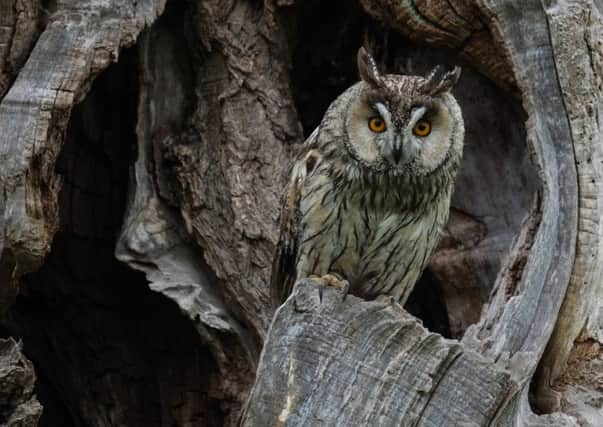Birdwatch: Sneaky sightings of elusive long eared species here to roost


In winter they gather in roosts, often in stands of hawthorn next to water, and the place I visited has been frequented by them for several years.
The first one I found quite easily using my binoculars. It was perched quite high in a hawthorn bush and was evidently aware of me. Through my telescope I could see its orange eyes were open and the long tufts on its head were standing up - it was on alert.
Advertisement
Hide AdAdvertisement
Hide AdSoon I found a second bird, lower down than the first and somewhat paler, and sometime later a third one, much harder to see than the first two and with only a slight movement of its feathers in the breeze giving its presence away.
There were more that I missed as up to eight have been reported by other observers. Long-eared owls are superbly camouflaged and their striped plumage blends perfectly with the twigs and branches in which they sit for hours without any sound or movement until dusk falls before one by one they fly off to hunt voles and mice.
Long-eared owls are thinly distributed throughout Britain and these resident birds move only short distances from their breeding sites. Numbers are boosted in the autumn by the arrival of long-eared owls from Scandinavia, Finland and elsewhere in northern Europe and winter roosts can reach a dozen or more but numbers are usually half this.
In Europe roosts are often much larger. The Serbian town of Kikinda claims to have the largest roost of long-eared owls in the world with up to 1,000 each night in trees around the town centre. The civic authorities are very protective of their winter guests, fining anyone who disturbs them a hefty 2,000 Euros.
Advertisement
Hide AdAdvertisement
Hide AdDisturbance is a problem in this country too with some photographers forgetting elementary fieldcraft in their attempts to get that perfect picture and moving too close to roosts. This is why most long-eared owl roosts, including the one I watched (from a safe distance), are seldom publicised unless the birds are roosting in inaccessible places out of harm’s way.
There are also plenty of wintering short-eared owls in the region including three along with a hen harrier and juvenile pallid harrier at the Welwick Saltmarsh reserve in East Yorkshire.
Two black redstarts have been seen on the rocks at Scarborough’s Marine Drive while an Eastern race black redstart is still being reported at Skinningrove, Cleveland.
Two black-necked grebes and a great northern diver have been seen at Scarborough Harbour.
Advertisement
Hide AdAdvertisement
Hide AdWhite-fronted geese were reported at several places along the Yorkshire coast including 20 over Spurn while one was seen inland at the Adwick Washlands, South Yorkshire. A tundra bean goose was seen on the golf course at Sewerby.
A Siberian chiffchaff was present this week on the Potteric Carr reserve.